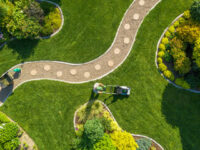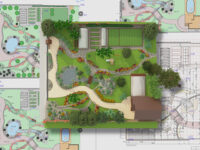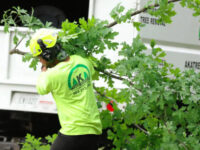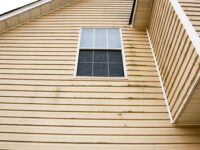Landscape Lighting – An Investment in the Beauty and Function of Your Yard
Whether it’s highlighting your herringbone walkway for safety reasons or illuminating your prized jasmine trellis wall to add curb appeal, landscape lighting is an investment in the beauty and function of your yard.
Integrated fixtures have an LED board built into them, so you can’t change the bulb. Instead, it would help if you replaced the entire fixture. Contact Landscape Lighting Orlando today!

When done well, lighting creates a warm glow that makes your landscaping look beautiful at night. It can also make your outdoor spaces more usable after dark, making them a place to enjoy dinner parties and other events with friends and family.
There are several strategies for landscape lighting, but uplighting and downlighting are two of the most popular. When used correctly, these techniques can highlight some of the most eye-catching features of your home’s landscape.
The key difference between uplighting and downlighting is direction. In uplighting, landscape lights are mounted below something you want to highlight or at ground level, shining the light upward. In contrast, downlights are installed high in trees or on the eaves of your house, shining the light downward.
Uplighting is a great way to show off a special tree, a garden statue, or a dramatic rock feature in your yard. It’s also a good way to illuminate tall structures like fences or walls. This type of landscape lighting can create a sense of enclosure around your yard, making it more private and secure at night.
One of the challenges with uplighting is that it can take time to get a consistent glow. You’ll need to carefully plan your lights so they all have a similar intensity and look attractive from multiple angles. If your uplights aren’t aimed properly, they can even shine into the street or your neighbor’s homes, creating a safety hazard.
When uplighting a large tree, it’s best to use more than one fixture to spread the light evenly over the entire canopy of leaves and branches. You can also use uplighting to highlight interesting bark patterns, the colors of the leaves, or a particular feature in the tree trunk. Uplighting also works great for low statues or other small features in your garden. Just be careful not to overdo this, as too much uplighting can be overpowering and distract from the beauty of your garden at night. Instead, aim for a soft wash of light with the right amount of detail to highlight your favorite features without detracting from the overall impact of the garden.
While uplighting highlights architectural detail on your home or structures, downlighting accentuates ground-level features such as landscape beds, water features, seating areas, and even flagpoles. A well-designed lighting scheme incorporates uplighting and downlighting for a beautiful glow, warm ambiance, and a great mix of brightness and shadows.
A professional landscape lighting contractor will know when to use uplighting or downlighting to illuminate your property. They can combine these elements in a lighting design to provide the best effect for your Chicago area home.
Downlighting in landscape lighting is accomplished by mounting lights to a structure so that they shine downward. Typically, landscape lights are aimed at the base of a tree to highlight the trunk and lower branches. Still, they can also be positioned to illuminate other elements, such as walkways or even an entertainment patio.
Lighting up a tree in this way can be very dramatic and is often referred to as moonlighting, although the effect will vary depending on the tree itself and the location of the light within the canopy. It’s also important that your chosen professional has experience working safely on ladders and in trees and knows how to properly place a light to not interfere with the tree’s health.
Uplighting is more of an art form that the experienced landscape lighting contractor will learn over time, but there are a few general guidelines to follow when uplighting a structure or tree. For instance, it is important to choose a light that is “lamp-ready” and has the option to take a standard bulb (instead of requiring a special halogen bulb). This allows for more customization regarding lumens, color temperature, and beam spread, whereas integrated fixtures offer limited options when changing a bulb.
Lastly, choosing a fixture made of copper or brass will ensure that it can stand up to the rigors of an outdoor installation. Low-quality fixtures are more likely to rust over time and can lead to electrical issues, particularly in the winter when snow and ice can cause water to enter the fixture. This can cause problems with the circuitry and short-out bulbs, leading to a less-than-optimal illumination of your landscape.
There are several different lighting techniques to use in your landscape. These include path lighting to light paths and providing a seamless transition between different scenes, grazing to create a steeply angled light to accent texture on walls and tree trunks, cross-lighting to highlight the 3D form of statues or other features by illuminating them from two or more sides, moonlighting to provide soft natural lighting over large areas, and shadowing to define surface texture by casting interesting shadows.
All of these lighting techniques can be used to add dramatic flair to your landscape design. However, implementing these lighting techniques requires careful planning and consideration to get the desired results. It is also important to work with a landscape lighting company that understands the intricacies and proper application of these techniques to ensure your project succeeds.
Safety: Properly illuminated outdoor spaces help to make your property safer by revealing the edges of pathways and any irregularities that could pose a trip risk. This is particularly true for stairs and walkways.
Beauty: When done properly, landscape lighting can evoke strong aesthetic and emotional responses from guests. This is especially true for highlighting centerpiece trees, flagpoles, and other decorative elements on your property.
Usage: Landscape lighting can make your property more usable after the sun goes down by providing illumination for your patios, decks, and other areas that aren’t easily accessible during the day. This can be an especially great feature for those who have a pool or hot tub on their property and want to encourage after-hours swimming without increasing the risk of injury.
While you can implement these different landscape lighting techniques on your own, working with a professional landscape lighting company will save you time and money and ensure that the results of your landscaping project meet or exceed your expectations. Contact the experts at VOLT Lighting to learn more about our landscape lighting services and how we can use them to enhance your property’s beauty, usage, and safety.
Landscape lighting enhances the ambiance of your home, garden, or water feature after dark and helps increase safety on your property. It also adds to your curb appeal and can boost your home’s value if you sell it. A well-lit exterior is also a deterrent to burglars, as it draws their attention and makes the property more visible to passersby.
Accent lighting is another great way to highlight a specific aspect of your outdoor space. Spotlights and track lights are often used for this purpose, as they allow the light to be focused on smaller areas of your yard. The light can be adjusted to different wattages depending on the desired amount of brightness.
Other types of lighting include floodlights, which aim to light down and are perfect for lighting walkways, retaining walls, or other large areas of your yard. In addition, path lights are similar to spotlights but are designed for flowerbeds and other low-level areas of your landscaping. As you walk past them, these lights illuminate the ground, removing any potential tripping or falling hazards.
When choosing your landscape lighting, it is important to consider how much you want to spend on the project. While it is easy to find inexpensive options, you’ll often get better results by hiring a professional landscape lighting designer who can create a custom plan for your property. The design process will consider your style, needs, and budget.
The type of voltage and installation method are also important factors to consider. Line voltage requires a licensed electrician, but low-voltage landscape lighting is safer for DIY installation and can be controlled with your smartphone or voice-activated home devices. When choosing a transformer, ensure it can power your desired number of lights and be upgraded later.
Once your landscape lighting is in place, performing regular maintenance is important. This includes cleaning the fixtures to remove any build-up or debris that can cause the bulbs to short out. In addition, moisture can be damaging to the fixture itself and the wiring. It is a good idea to wipe away any snow that has built up on your lights and any debris from winter rain or wind. Moisture can also lead to corrosion, which will further shorten the lifespan of your landscape lighting.





